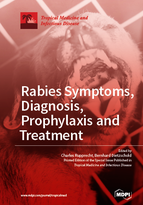Rabies Symptoms, Diagnosis, Prophylaxis and Treatment
A special issue of Tropical Medicine and Infectious Disease (ISSN 2414-6366).
Deadline for manuscript submissions: closed (30 June 2017) | Viewed by 144538
Special Issue Editors
2.CEO, LYSSA LLC, Lawrenceville, GA 30044, USA
Interests: lyssaviruses; zoonoses; One Health; epidemiology; conservation biology
Special Issues, Collections and Topics in MDPI journals
Interests: molecular parthenogenesis of rabies; protective immune responses against rabies; development of live-attenuated rabies virus recombinant vaccines; development of monoclonal antibodies for post-exposure treatment of human rabies
Special Issue Information
Dear Colleagues,
Rabies is an acute progressive encephalitis, caused by highly neurotropic lyssaviruses, with the highest case fatality of any infectious disease, yet remains neglected at a global scale, particularly in poor rural areas of Asia, Africa and the Americas.
Recently, staff from FAO (Food and Agriculture Organization of the United Nations), OIE (World Organisation for Animal Health), WHO (World Health Organization) and global opinion leaders met to discuss a path forward for the elimination of human rabies mediated by dogs by 2030, employing a coordinated mass canine vaccination program. In a true One Health context, a transdisciplinary approach is necessary to fulfill such a goal. Not only will success be measured in the proportions of dog populations vaccinated, but also parameters to herald progress by a substantive decrease in human rabies cases.
Therefore, understanding how to better measure and monitor the human rabies burden, make salient progress with existing biologics in medical portfolio, ensure the health economics data remain positive and balance the prevention approach with the expectations and ethics of individual case intervention, are concomitant public health issue, as plans for canine rabies elimination unfold.
Despite being one of the oldest known diseases, questions about rabies abound in the 21st century. For example: Are we missing human rabies fatalities due to changes in clinical manifestations or is there another explanation for the paucity of confirmed cases? Why do people still die of rabies? Do diagnosticians in developed countries expect too much from laboratory workers in GAVI-eligible countries (GAVI: Global Alliance for Vaccines and Immunization)? How can pathogen detection be improved realistically in the field? Is the apparent virulence and pathogenesis of various lyssaviruses different? Can rabies prophylaxis be administered safely without the necessity of rabies-immune globulin? What is being missed in a more holistic approach to rabies treatment? Will the focus upon human rabies alter the prioritization and timetable of canine rabies elimination? Who are the new collective advocates and supporters to move the agenda forward by over the next decade?
In this Special Issue, we will focus upon basic research, clinical studies and case reports that contribute to translational improvements in laboratory-based surveillance, diagnostics, pathobiology, prophylaxis and experimental therapy of human rabies.
We look forward to your provocative contributions on this inter-related topic.
Dr. Charles RupprechtProf. Dr. Bernhard Dietzschold
Guest Editors
Manuscript Submission Information
Manuscripts should be submitted online at www.mdpi.com by registering and logging in to this website. Once you are registered, click here to go to the submission form. Manuscripts can be submitted until the deadline. All submissions that pass pre-check are peer-reviewed. Accepted papers will be published continuously in the journal (as soon as accepted) and will be listed together on the special issue website. Research articles, review articles as well as short communications are invited. For planned papers, a title and short abstract (about 100 words) can be sent to the Editorial Office for announcement on this website.
Submitted manuscripts should not have been published previously, nor be under consideration for publication elsewhere (except conference proceedings papers). All manuscripts are thoroughly refereed through a single-blind peer-review process. A guide for authors and other relevant information for submission of manuscripts is available on the Instructions for Authors page. Tropical Medicine and Infectious Disease is an international peer-reviewed open access monthly journal published by MDPI.
Please visit the Instructions for Authors page before submitting a manuscript. The Article Processing Charge (APC) for publication in this open access journal is 2700 CHF (Swiss Francs). Submitted papers should be well formatted and use good English. Authors may use MDPI's English editing service prior to publication or during author revisions.
Keywords
- Diagnosis
- Encephalitis
- Lyssavirus
- Neglected diseases
- Prophylaxis
- Rabies
- Surveillance
- Therapeutics
- Viral infections
- Zoonosis








